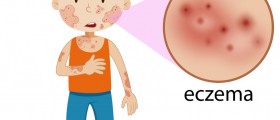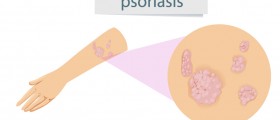
Skin rash represents a body's reaction and is a sign of different medical conditions, some of which directly affect the skin while others originally affect other organs.
Skin rash forms on one part of the skin. It may remain localized or spread further affecting even greater portions of the skin. The skin changes may remain separated or merge together.
Skin rash may develop in three forms. The first one includes scaly patches not caused by infection, the second one is the same as the first one but it is associated with fungal or bacterial infection, and the last form of skin rash is the one comprising red, itchy bumps or patches.Atopic Dermatitis
Atopic dermatitis is inflammatory, non-contagious, pruritic skin disorder associated with frequent relapses. It is considered a hereditary disease. The condition first occurs during childhood and develops in a form of red, scaly patches that affect the cheeks, scalp, arms, legs and torso. Later in the patient's life the skin changes predominantly affect the elbows and knees. In adults atopic dermatitis occur more on the hands, around the eyelids and on the genitalia. Even the entire skin can get affected.
Many people suffering from atopic dermatitis also suffer from other allergic illnesses such as asthma, hay fever etc. The condition gets worse during winter months and some people complain about aggravation of symptoms during the summer.
The skin of atopic dermatitis is inflamed, red and itchy. The patches may appear swollen (and they actually are) and cracked. There may also be crusting. Liquid oozing out of such crusts is sterile.
Atopic dermatitis is most severe during childhood. It is treated with conservative treatments including prescription-strength steroids (cortisone creams) as well as some nonsteroidal creams. It is also essential to minimize irritation of the skin, and this way prevent flare-ups.
Contact Dermatitis
Contact Dermatitis is another skin condition accompanied by red, itchy rash. It develops due to a contact with a specific substance or material which irritates the skin. Contact dermatitis may be, for example, induced by touching poison oak or ivy, jewelry made of certain metals or clothes previously washed with some harsh detergents.
In contrast to atopic dermatitis, which may affect large portions of the skin, contact dermatitis affects only the skin that has been in a direct contact with the trigger.
Because the actual cause of the rash is known, the susceptible person should avoid any contact with the particular substance or material. In case contact dermatitis develops, one may benefit from topical steroids and non-steroidal creams.
Apart from these two quite common conditions associated with red, itchy rash there are many more which need proper evaluation and treatment. Only a well-experienced dermatologist can diagnose the underlying cause of such rash and recommend the most suitable treatment.

















Your thoughts on this
Loading...